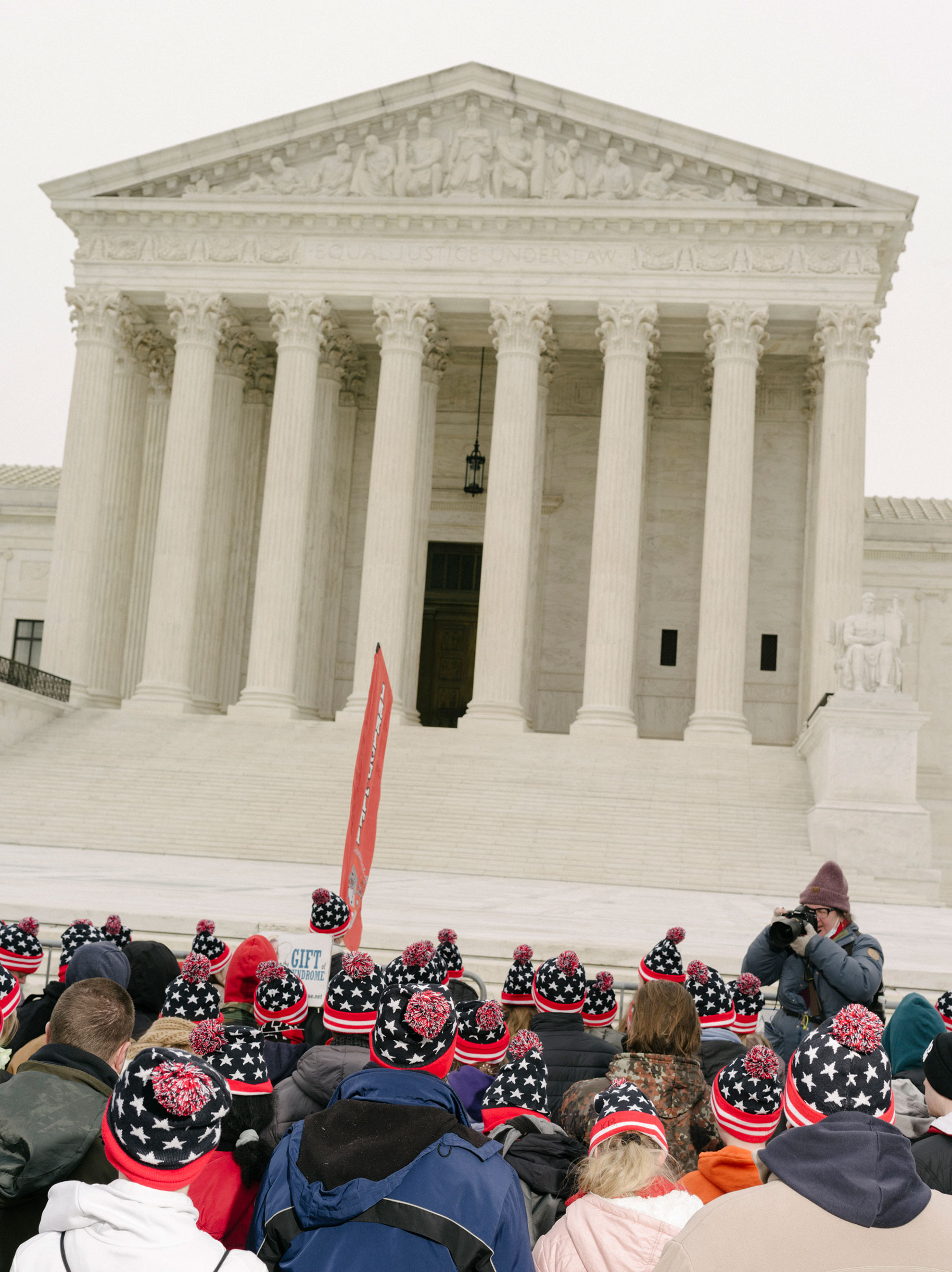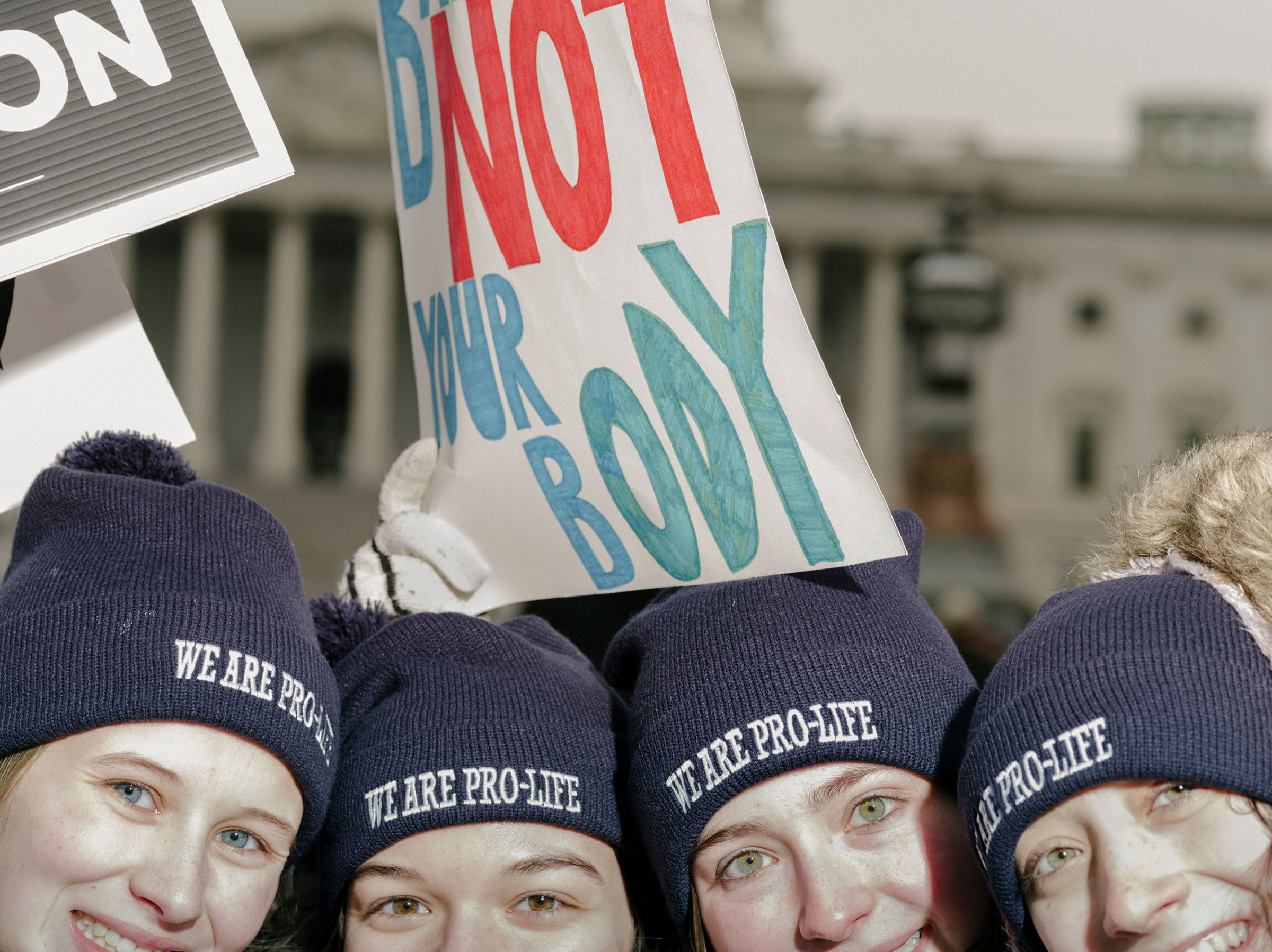On a cold, clear weekend in January, tens of thousands of anti-abortion activists convened in Washington for their annual gathering, the March for Life. The mood was triumphant. In the next few months, the U.S. Supreme Court is widely expected to pare back or overturn Roe v. Wade, the 1973 Supreme Court decision that established the constitutional right to abortion. Anti-abortion activists have been fighting for this moment for nearly a half century. For three days surrounding the march, they danced and prayed and tearfully embraced in the streets.
But under the surface, the weekend was fraught with tension. For decades, the well-organized, largely grassroots movement has worked to unite a diverse cross-section of American society behind their cause: white evangelicals, as well as some Catholics, Black protestants, Hispanics, and conservative Democrats. Now, with their goal finally in sight, the different factions of the movement have disparate ideas of what a post-Roe world might look like, and how the movement should channel its considerable political power toward achieving those visions.

Some anti-abortion leaders, trumpeting messages of civil rights and female empowerment, are calling for a more robust social safety net that would bolster support for mothers and babies. Others are more focused on banning abortion, convinced that passing legislation to criminalize it and discourage providers from practicing will more quickly achieve their goal of eliminating the practice nationwide. There’s a fracture between anti-abortion absolutists, who want to outlaw all abortions as soon as possible even if their laws are not upheld, and incrementalists, who see more limited bans as ways to appeal to public or judicial opinion while moving toward the end goal of eliminating abortion nationwide.
At the same time, a bevy of right-wing groups—Christian nationalists, conspiracy theorists, and white-power extremists—already flourishing in a Republican Party shaped by Trump, see a political opportunity in recruiting and proselytizing among the movement’s splintering ranks, says Mike Madrid, a veteran Republican strategist who has been critical of the party’s rightward lurch in the Trump era. And the GOP itself is increasingly using the power of state and local governments to push back on not just abortion, but other cultural changes, such as transgender rights and teaching about LGBTQ people, around the country.
The Supreme Court is expected to rule on Roe by this summer—just months before the 2022 midterms. Almost any decision it renders, legal experts say, will give the states more power to determine questions of abortion access. As a result, state and local anti-abortion groups are already pushing state legislatures to adopt laws that would ban abortion and criminalize the people who help patients obtain them. At this critical political moment, it’s hard to predict the impact of a Court ruling on the upcoming elections: the effort could galvanize Republican voters, energize Democrats, or both.


For all the anticipation of the court’s decision, advocates and scholars alike say it’s also difficult to predict where the energy of the movement will go if Roe is struck down. “Overturning Roe v. Wade will not be the end of the pro-life movement,” said Michael Knowles, a conservative commentator and final keynote speaker at the National Pro-Life Summit in January. “It will only be the beginning.”
A long history of strange bedfellows
Tension within the anti-abortion movement is not new. Early opposition to abortion in the 19th century was driven in part by concerns that it would curtail the births of white Anglo-Saxon Protestants, while allowing others—at the time, Catholic immigrants—to replace them demographically. Well into the 1980s and ’90s, anti-abortion terrorists had ties to white, antisemitic groups and borrowed tactics from the Ku Klux Klan.
Mainstream anti-abortion activists have long grappled with the challenge of how to keep extremist elements of the movement at bay. As early as the 1960s and 1970s, anti-abortion groups sought to used language designed to have broad, moral appeal—invoking comparisons to the Civil Rights movement and the Holocaust, says Jennifer Holland, an associate history professor at the University of Oklahoma, who studies the anti-abortion movement. “For a lot of conservative white people, a civil-rights movement for fetuses was this compelling way to re-narrate white conservatives not as segregationists, but as abolitionists,” Holland says. “Unlike other socially conservative movements, they really have co-opted the language of the left.”

After Roe, the anti-abortion movement used this rhetoric to help push a Constitutional amendment banning abortion outright. When that failed, they were forced to regroup. Republicans seized on abortion as a way to motivate voters, and the movement turned to a new shorter term goal of pushing GOP state legislators to advance incremental laws that gradually, and often indirectly, restricted access to abortion. In the 1980s, ’90s, and 2000s, states passed hundreds of restrictions mandating waiting periods, excluding abortion from insurance coverage, and adding onerous requirements for abortion clinics that caused them to close. The second, longer-term goal was to push Republican Presidents to nominate anti-abortion conservatives to federal and appellate benches, and particularly the Supreme Court, with the hope of eventually overturning Roe.
When anti-abortion violence in the 1990s brought the movement negative attention, activists embraced language centered on protecting women. In 2020, March for Life selected the slogan “Life empowers: pro-life is pro-woman.” Mississippi’s Attorney General Lynn Fitch last year used a similar phrase—“empower women, promote life”—to embody her approach to defending her state’s anti-abortion law that is at the center of the case before the Supreme Court.
“We’re all equal in dignity regardless of skin color, disability status, socioeconomic background or stage of life—including the earliest stages in life,” March for Life President Jeanne Mancini said at this year’s January gathering, looking out at a sea of signs brandishing quotes from Martin Luther King, Jr., declaring that keeping a baby is empowering, and comparing abortion to slavery.

Mancini and her staff carefully chose this year’s theme, “equality begins in the womb,” to relate to recent national conversations around racial injustice. Several speakers at the March likened the movement to Black Lives Matter and the fight for gender equality; Mancini herself decried abortion as the “single most critical human rights abuse of our time.”
This messaging strategy has been effective, particularly among young people. Students for Life of America, which mostly recruits on high school and college campuses, started in 2006 and now has more than 1,200 chapters in all 50 states. In 2020, it partnered with other powerful conservative groups to launch its first National Pro-Life Summit; more than 2,000 young activists signed up to attend the day-long training in January. While the majority of Americans ages 18-29 support the right to abortion, the issue often isn’t a priority; in contrast, young people who oppose abortion are often passionate about the issue.

Bailey Travis, a white student from Ball State University in Indiana who says she’s concerned about both racism and abortion, attended a a panel at the January summit called “Black Lives Matter from Womb to Tomb.” She was pleased to hear the message that abortion was harmful for Black people specifically. “I was really happy to see it because I grew up in a multicultural family and so being able to find a relationship between the two [movements] is really promising for the future,” she says.
Lauren Marlowe, a social-media coordinator at Students for Life, frames her opposition to abortion in terms of her commitment to feminism and equality. It bothers her, she says, when women say they wouldn’t have been able to have their careers if they hadn’t had an abortion. “There’s no way that equality can come from taking the rights away from an entire people group like that,” she says.
A fundamental shift at the Supreme Court
The rush to knock down Roe became frenzied with the addition of three conservative Supreme Court justices during the Trump presidency. Republican-led legislatures began competing to be the state to overturn Roe, passing ambitious new anti-abortion bills that would have been dismissed just a few years earlier. In 2019, Georgia, Kentucky, Louisiana, Mississippi and Ohio all passed laws banning abortion once fetal cardiac activity can be detected, which is around six weeks into pregnancy. Alabama passed a ban on nearly all abortions with no exceptions for rape or incest. Missouri also provided no rape or incest exceptions in a law banning abortion after eight weeks—and expecting that its law would be blocked, it included bans on abortion at 14 weeks, 18 weeks and 20 weeks in the same bill.


The apotheosis of this change was the Supreme Court’s announcement last May that it would consider the constitutionality of a Mississippi law banning abortion after 15 weeks. The Court’s decision to take up the case was extraordinary on its own: the Mississippi law is so clearly unconstitutional under current precedent that every lower court, including the famously conservative Fifth Circuit Court of Appeals, had rejected it. The high Court appeared to be signaling that it was prepared to reconsider Roe.
State lawmakers again took their cue. In the past year, Texas banned abortion after about six weeks, using a new private-enforcement mechanism that has so far made the law impossible to block, even though it contradicts the court’s decision in Roe. Just this month, the Texas Supreme Court closed off the last main avenue abortion providers had to challenge the law, and Idaho passed a similar six-week ban. Florida and Arizona recently passed 15-week bans modeled on Mississippi’s law. Oklahoma is moving a host of abortion restrictions, including two different bills that would use the Texas-style enforcement and one that would ban abortion after 30 days from a woman’s last menstrual period, effectively banning all abortions. Legislators in Kentucky are considering bills that abortion providers in the state say would completely shut them down and remove all access. And in Missouri, lawmakers have introduced bills that would treat the delivery or shipment of abortion pills as drug trafficking, ban abortions for people with ectopic pregnancies—putting their lives at risk in the process—and employ Texas’s private enforcement mechanism that allows individuals to sue each other, to prevent residents from leaving the state to obtain an abortion even where it is legal. (Lawmakers dropped the ectopic pregnancy provision after public outcry.)

“States are really pushing up to the edge of what’s possible in anticipation and expectation of what may happen with Dobbs,” says Sue Liebel, state policy director at anti-abortion group Susan B. Anthony List, referring to the Supreme Court case over Mississippi’s abortion law.
If the Supreme Court overturns Roe, 12 states have laws in place that would ban abortion almost immediately; another nine states have laws already written prohibiting the procedure that they could move to implement within months. Fifteen have laws protecting abortion access and the remaining states could see even more intense battle. “For the past 15 years at Students for Life, we’ve been building towards a strategy of getting this pro-life generation built up, getting them trained and experienced on the ground, to be ready on that day the Roe decision comes down,” says Kristan Hawkins, the group’s president and founder.
Many leaders in the movement say they want to make abortion not just illegal but “unthinkable” in the future. They expect to see more unwanted pregnancies if Roe is overturned, and they are launching public awareness campaigns for crisis pregnancy centers, pushing colleges to improve services for pregnant and parenting students, and promising to lobby states to invest in policies that would support mothers and families. “We’ve got to expand our thinking about what we can and should do through law and policy to foster a stronger and more life-giving America,” says Catherine Glenn Foster, president and CEO of Americans United for Life (AUL).

Preparing for a ‘post-Roe world’
As the Supreme Court decision nears, some of these ideas are being drowned out by the more extreme policies that anti-abortion activists are pushing in states. “It’s not just that there’s sort of an insurgency in the anti-abortion movement, it’s that folks who have that point of view have the ear of legislators in a lot of places, and sometimes are actually legislators in places,” says Mary Ziegler, a law professor at Florida State University who specializes in the history of abortion law. “You have less of an ability for the national movement to control what’s coming out of states.” Despite many anti-abortion advocates’ rhetoric about increasing support for families, Republican-led states have so far passed limited legislation to do so, opting mostly to fund abortion alternatives programs that give money to largely faith-based crisis pregnancy centers. In contrast, states passed 108 abortion restrictions last year, the highest number since 1973.
In the past, anti-abortion activists were able to separate themselves from more fringe supporters by allying with Republican politicians, who for the most part embraced a genteel rhetoric with regard to race and gender. Under Trump, those narrow spaces collapsed: dog whistles turned to direct insults and threats escalated. While the GOP used to represent several major ideologically aligned groups—fiscal conservatives, national defense hawks, and anti-abortion advocates—that’s no longer the case. The current Republican Party platform is not built on pro-actively creating a socially conservative society so much as as wielding the power of government to stop cultural changes, like access to medical care for transgender kids and educating children about “divisive concepts.” Empowering private citizens to sue abortion providers has become empowering parents to sue their child’s school for teaching about LGBTQ people.

In 2020, abortion clinics reported an increase in vandalism, stalking, violence and death threats, according to the National Abortion Federation. Anti-abortion activists were among the insurrectionists at the Capitol; at the March for Life rally in January, far-right Rep. Marjorie Taylor Greene stood alongside other Republican lawmakers on the main stage as the crowd applauded. Multiple white nationalist groups attended the march.
Some abortion opponents are alarmed by the presence of extremists within the anti-abortion movement’s big tent. At the rally in January, Destiny Herndon-De La Rosa, who leads the New Wave Feminists group and identifies as a political Independent, confronted the white-nationalist group Patriot Front. The March for Life’s Mancini issued a statement condemning “any organization that seeks to exclude a person or group of people based on the color of their skin or any other characteristic” and saying “such exclusion runs counter to our mission which recognizes that all human lives are equal from the moment of conception.”
But Herndon-De La Rosa says she has been disappointed by the movement’s embrace of Trump, and notes the D.C. rally was hardly a one-off. Patriot Front and other groups have appeared at other anti-abortion events. “If we are marching and we are saying that all lives have dignity and value, and we are welcoming people that don’t believe that,” says Cherilyn Holloway, founder of Pro-Black Pro-Life, “then I think that you’re doing a disservice to the overall cause.”

Even if the presence of extremists makes many anti-abortion leaders uncomfortable, the movement shows no signs of separating from the Republican Party, including its Trump-inspired coalition, anytime soon. While state laws may be the focus right now, the anti-abortion movement still wants abortion to be illegal across the country, and will need another national strategy after Roe to achieve that longer term goal. “Probably the easiest way you get to abortion being illegal everywhere is if the Supreme Court says that abortion is unconstitutional. And again then you need a partner that will confirm and nominate the right kinds of people to get to that outcome,” says Ziegler.
Democrats have almost entirely unified behind support for abortion rights, and the anti-abortion movement has steadfastly aligned itself with Republicans in recent years. So as long as the GOP remains enthralled to Trump, the post-Roe future is likely to follow suit.
“The pro-life movement is now essentially operating in service of the MAGA movement, because they don’t feel like they have anywhere else to go,” says Sarah Longwell, a GOP political strategist who founded the anti-Trump Republican Accountability Project. “If that’s their only issue that matters to them, they likely will accommodate—they clearly have accommodated—lots of other bad behavior.”
More Must-Reads from TIME
- Cybersecurity Experts Are Sounding the Alarm on DOGE
- Meet the 2025 Women of the Year
- The Harsh Truth About Disability Inclusion
- Why Do More Young Adults Have Cancer?
- Colman Domingo Leads With Radical Love
- How to Get Better at Doing Things Alone
- Michelle Zauner Stares Down the Darkness
Write to Abigail Abrams/Washington, D.C. at abigail.abrams@time.com
